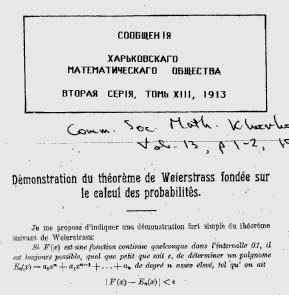Bernstein's Démonstration du théorème de Weierstrass
I propose to give a very simple proof of the following theorem of Weierstrass:
If \( F(x) \) is any continuous function in the interval [0,1], it is always possible, regardless how small \( \varepsilon \), to determine a polynomial \( E_n(x) = {a_0 x^n + a_1 x^{n-1} + \cdots + a_n} \) of degree \( n \) high enough such that we have \[ {|F(x) - E_n(x)|} < \varepsilon \] for every point in the interval under consideration.
To this end, I consider an event \( A \), whose probability is equal to \( x \). Suppose \( n \) experiments are conducted and that is agreed to pay a player the sum \( F({m \over n}) \), if the event \( A \) occurs \( m \) times. Under these conditions, the mathematical expectation \( E_n \) for the player will have the value
\[ \begin{equation}{E_n = {\sum_{m=0}^{m=n} F\left({m \over n }\right) \cdot C_n^m \cdot x^m \cdot ({1-x})^{n-m}}.} \tag{1} \end{equation} \]
It follows from the continuity of the function \( F(x) \) that it is possible to set a number \( \delta \), such that the inequality
\[ {|x - x_0|} \leq \delta \]
causes
\[ {|F(x) - F(x_0)|} < {\varepsilon \over 2}; \]
so that, if \( \overline{F}(x) \) is the maximum and \( \underline{F}(x) \) the minimum of \( F(x) \) in the interval \( (x - \delta, x + \delta) \), then
\[ \begin{equation}{{\overline{F}(x) - F(x)} < {\varepsilon \over 2}, \;\;\; {F(x) - \underline{F}(x)} < {\varepsilon \over 2}.} \tag{2} \end{equation} \]
Let \( \eta \) be the probability of the inequality \( {|x - {m \over n}|} > \delta \) and \( L \) the maximum of \( |F(x)| \) in the interval \( [0, 1] \).
We then have
\[ \begin{equation}{{\underline{F}(x) \cdot (1 - \eta) - L \cdot \eta} < E_n < {\overline{F}(x) \cdot (1 - \eta) + L \cdot \eta}.} \tag{3} \end{equation} \]
But by virtue of a theorem of Bernoulli, we can take n large enough to have
\[ \begin{equation}{\eta < {\varepsilon \over 4L}.} \tag{4} \end{equation} \]
Inequality (3) will in turn take the form
\[ {F(x) + (\underline{F}(x) - F(x)) - \eta (L + \underline{F}(x))} < E_n < {F(x) + (\overline{F}(x) - F(x)) + \eta (L - \overline{F}(x))} \]
and so
\[ {F(x) - {\varepsilon \over 2} - {2L \over 4L} \varepsilon} < E_n < {F(x) + {\varepsilon \over 2} + {2L \over 4L} \varepsilon}; \]
therefore
\[ \begin{equation}{{|F(x) - E_n|} < \varepsilon} \tag{5} \end{equation} \]
\( E_n \) is clearly a polynomial of degree n.
The theorem is therefore proved.
I would only add two points.
The approximate polynomials \( E_n (x) \) are especially convenient, it seems to me, when you know exactly or approximately the values of \( F(x) \) for \( x = {m \over n} (m = 0, 1, \cdots n). \)
Formula (1) and inequality (5) show that, for any continuous function \( F(x) \):
\[ F(x) = {\displaystyle \lim_{n \rightarrow \infty}}{\sum_{m=0}^{m=n} F\left({m \over n }\right) \cdot C_n^m \cdot x^m \cdot ({1-x})^{n-m}}. \]
Translated by Mike Bertrand (Mar 6, 2015).
